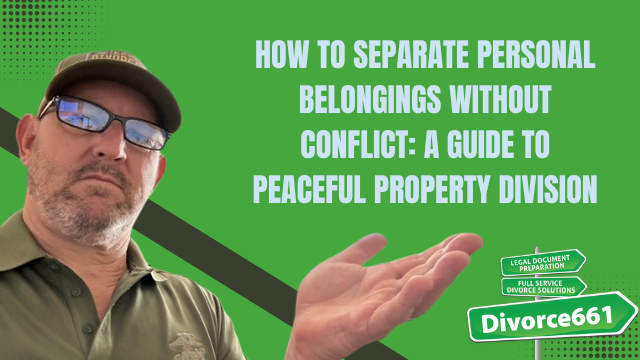How to Separate Personal Belongings Without Conflict: A Guide to Peaceful Property Division
Dividing personal belongings during a divorce can be surprisingly emotional and challenging. While many focus on major assets like homes, bank accounts, or custody arrangements, the process of separating furniture, keepsakes, electronics, and sentimental items often stirs the most tension. The good news is that with the right approach, this part of the divorce doesn’t have to turn into a battle.
Drawing from practical experience helping couples navigate these tricky waters, here’s a clear and respectful method to separate personal belongings peacefully, ensuring fairness and minimizing conflict.
Start with a Calm and Respectful Tone
One of the most important foundations for dividing personal property without conflict is agreeing upfront on a calm, respectful tone for the process. When both parties commit to cooperation rather than confrontation, the path becomes smoother and less stressful.
Setting this tone can mean agreeing on ground rules such as:
- Listening without interrupting
- Avoiding heated arguments over small items
- Being open to compromise and creative solutions
Make a Complete List of Personal Belongings
Organization is key. Begin by making a comprehensive inventory of all personal property, especially items of significant value. This includes:
- Furniture
- Electronics
- Jewelry
- Artwork
- Sentimental keepsakes and family heirlooms
Having everything listed in one place prevents surprises and helps both parties clearly see what needs to be divided.
Use Fair Methods to Decide Who Keeps What
Once you have a list, it’s time to decide who keeps which items. Fair, simple approaches can prevent unnecessary disputes. Some effective methods include:
- “You pick one, I pick one”: Taking turns selecting items from the list to ensure balanced choices.
- Assigning items based on usage: Letting the person who uses the item most keep it.
Keep in mind that arguing over low-value items often isn’t worth the emotional toll. If the cost of fighting over something exceeds its replacement value, it’s usually best to let it go.
Understand Ownership vs. Emotional Attachment
It’s important to remember that emotional attachment doesn’t always equal legal ownership. For example, items acquired before the marriage or received as personal gifts might legally belong to only one party, regardless of sentimental value.
This distinction can help keep discussions grounded and focused on fairness rather than feelings alone.
Handling Sentimental Items and Family Heirlooms
Sentimental belongings like photo albums, family heirlooms, or other cherished keepsakes often carry deep emotional weight and can be the hardest to divide.
Consider these options to reduce tension:
- Make copies or digital backups of photo albums and documents.
- Share items on a rotation basis, especially if children are involved and want access to the heirlooms.
- Use creative financial arrangements, such as one spouse keeping the heirlooms while the other receives a fair-value credit toward different assets.
“We recently worked with a couple stuck on dividing family heirlooms. Instead of going to court, they agreed that one spouse kept the items while the other received a fair-value credit toward another asset. This kept things balanced and respectful without unnecessary tension.”
Communication and Compromise Are Key
Open communication and a willingness to compromise are essential to avoiding resentment and prolonged conflict. When both parties feel heard and respected, it’s easier to reach agreements that work for everyone.
Written agreements detailing who gets what can also prevent misunderstandings and provide clarity moving forward.
How Professional Support Can Help
At Divorce661, we specialize in helping couples resolve even the smallest details in a clear, cooperative way. Whether it’s listing assets, facilitating discussions, or preparing written agreements, our flat-fee services are designed to keep your divorce smooth, fair, and drama-free.
If you’re struggling to divide personal belongings or want to avoid conflict during this emotional process, consider scheduling a free consultation. We’ll help you stay organized, protect your interests, and reach peaceful resolutions so you can move forward confidently.
Final Thoughts
Dividing personal belongings after a divorce doesn’t have to be a source of conflict. By approaching the process with respect, clear communication, and practical strategies, you can separate your personal property fairly and peacefully.
Remember to:
- Agree on a respectful tone.
- Make a complete list of belongings.
- Use fair methods like “you pick one, I pick one.”
- Recognize the difference between emotional attachment and legal ownership.
- Find creative solutions for sentimental items.
- Keep communication open and document agreements clearly.
Taking these steps can help you avoid unnecessary drama and focus on building your new chapter with clarity and peace.

